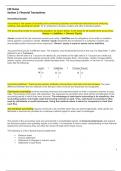Summary
Summary CFE Certified Fraud Examiner - Financial Transactions Study Guide
- Course
- Institution
ACFE CFE Financial Transactions section study guide. Notes/Summary from study material used to help point out key terms and essential information to prepare for the exam. **These are not exam answers, this is the study guide I created and used personally to pass the exam on the first try.
[Show more]



